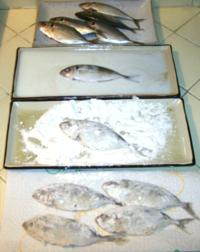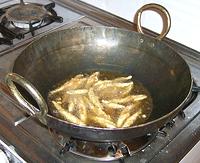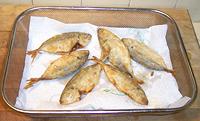
Fish Page

Batter Line

Smelts frying

Wire skimmer

Draining

Smelts Served

Kadhai

Spider

Basket Fryer
Procedure
The examples here are Smelt, which I recommend, and Salay Salay which I don't particularly recommend due to boniness. Smelt can be eaten "head guts and feathers", though I usually gut them.
- If you're using a marinade, get your fish soaking in it in the fridge. You want about 1/2 hour to 1 hour soak.
- Prepare any coating or batter you will use. The "Batter Line" photo shows a buttermilk dip followed by a tumble in all-purpose flour. Just a dusting of flour would do too.
- Make sure your fish is ready and dry. If it's been marinading, dry off any marinade it hasn't absorbed.
- Bring your oil up to temperature. The ideal temperature is 375°F/190°C. Keep your oil well below smoking temperature.
- Coat or batter just enough fish for one batch and just before putting it in the oil or the batter will be soggy.
- Make sure your oil is at the right temperature and put the fish in (being careful not to splash). Stir occasionally until sizzling decreases and fish is lightly browned.
- Scoop out with a wire spider or other device that allows the pieces to drain freely. Drain further on paper toweling and keep warm in the oven until ready to use.
Hints
Know Your Fish:
Hints for many kinds of fish are on the "Details and Cooking" pages linked from our Varieties of Fish page (very large page). Some fish stay firm and manageable while others tend break up. Coat delicate fish sufficiently to hold it together.Oil:
Use a durable high temperature oil - see our Cooking Oils for appropriate oils. I use Olive Pomace which has a high smoke point, no significant olive flavor, and is economical. Peanut Oil is also pretty good. I don't use high polyunsaturated oils like corn or soy which rapidly turn rancid when heated. Don't use Extra Virgin or any other "unrefined" oil - they can't stand the heat.Temperature:
Keep the temperature of your oil as close to 375°F/190°C as you can. Keep it well below smoking temperature at all times.Don't Overload Your Oil:
Fry in small batches so the temperature doesn't drop too far or you'll end up with heavy, oily fish with a steamed flavor. Small batches finish faster so it won't take much more time.Coating Fish:
While I fry some fish naked, most fish I give a light powdering of rice flour or all-purpose flour. Wheat flour will produce a darker brown than rice flour, but rice flour is lighter in flavor.Batter for Fish:
Many recipes call for coating fish with batter, sometimes much too heavy a batter. We're not frying pancakes here, we're frying fish. A quick dip in buttermilk followed by a dusting of lightly salted (or seasoned) flour is generally plenty. Dipping in egg will make the coating thicker.Marinading:
If you marinade fish, let them soak up the marinade for about 1/2 hour in the refrigerator. Fish spoil fast - don't leave them out. If you use leftover marinade for a sauce bring it to a high simmer for 5 minutes in a saucepan to make sure it's safe - it's been exposed to raw fish.Clean-up:
Clean oil off your stove as soon as possible. heat will dry the oil into varnish which becomes more difficult to remove with each passing hour.Re-using Oil:
Oil degrades with use, different oils at greatly different rates. Polyunsaturated oils (corn, soy, "vegetable") degrade rapidly and should never be reused, while Olive is relatively durable. See the "OSI/IOS" column in our Oil Chart page for relative durability (low OSI and high IOS numbers are better). Oil that isn't yet tired and hasn't been overheated can be used again within a reasonable time. Heat it long enough it no longer "pops", indicating all water has been evaporated, then Filter it still quite hot through one layer of plain (not printed) paper towel. Store in a tightly capped jar. Don't use oil used for fish to fry other things (unless you like them fish oil flavored).
Tools
- Fryer: The ideal device for deep frying modest quantities of just about anything is the Indian Kadhai, similar to a wok but with somewhat different geometry. The sides are wide enough and high enough to contain most of the splattering and it requires a very modest amount of oil to fry a reasonable amount of fish. They do a lot of deep frying in India and can't afford to waste oil.
Spider:
A wire spider will allow the fish to drain well as you remove it from the oil.- Basket Fryer: The Western basket fryer is an efficient and effective device but requires quite a bit of oil and tends to splatter a lot, so be prepared to do clean-up, lots of clean-up.
Thermometer:
An infra-red Surface Temperature Gun is ideal, but a thermometer with a long probe that goes up to at least 400°F/200°C can be used.